
ONTARIO

Port Stanley
NO PART OF THE FOLLOWING
ARTICLE AND PHOTOGRAPHS
MAY BE REPRODUCED WITHOUT
PERMISSION FROM THE AUTHOR ©
The Invererie Heights area above Port Stanley's beach on Lake Erie had been a popular location since at least the middle of the 1800s. The London Port Stanley Railway, built in 1856, drew many outsiders to the area for relaxation and recreation in the warm summer months. By the 1860s a cricket field and dance hall were there along with swings. Picnics drew thousands to the hill 30 metres or more above, and overlooking, the beach. They were so common that the area became known as "Picnic Hill". There would come to be gatherings of company, church, and ethnic groups, and over the years, sports events and musical entertainment became associated with them until beyond the mid 20th century.
This all proved popular enough that The Fraser House was opened on the hill in 1871. Its three stories contained 62 rooms (8 with a private bath), and a 200-seat dining room. The inn had a preview May 24th with the official opening June 8th. This proved so popular that later extensions would house more rooms, include an in-house laundry, have a billiards room, and supply stables for visitors' horses. The Fraser House gained an international reputation as the cream of the crop. This is evidenced by the fact that Canada's first prime minister, Sir John A. MacDonald, stayed there when in the region. The area even began to be referred to as "Fraser Heights".
The grounds were well-kept and featured groves with swings and benches. A staircase opposite the hotel's entrance driveway led to the beach and boat pier, where people fished and enjoyed the water. As that area built up, it became known as "Stanley Beach", although it was never named as such officially.
This important hotel drew even more people to the area who began to enjoy the beach. However, the only access was up & down the lengthy stairway, unless people wanted to walk the long way via George Street, which was quite steep. To make this easier, and to draw persons from the beach to the hotel, a steam-powered incline railway was installed. It had two tracks up the side of the hill, with one cable car running up & down each track.
|
Incline Railway
Circa 1890s or 19-0s
|
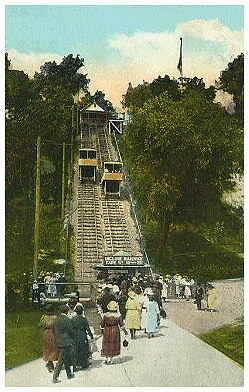
|
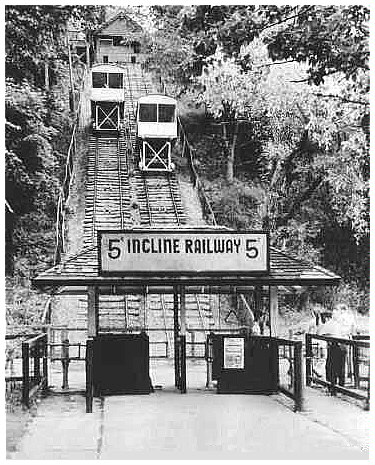
Elgin County Railway Museum Photo |
Incline Railway
The Date is unknown, but given the increase in vegetation growth, it is later than the above photo. Note the difference in the sign. |
The power source was an 1853 railway locomotive brought to the site expressly for this purpose. It had to be shipped in by train, then temporary rails placed to get it to the hill, and finally a winch to raise it to the top of the heights. There was enough energy left over from the locomotive to also power a carousel on the beach, which was added as a source of amusement. It's unknown how the power was transferred to do this, nor what year that ride opened.
Even after The Incline was made electric, the locomotive bell was kept and was a familiar sound at the site until The Incline would be removed in the 1960s. An exact date for the opening of The Incline railway has not surfaced, but it was likely in the early 1870s.
Shortly after the hotel and incline railway were built, an observation tower improved the already-high view from Picnic Hill even more. It consisted of seven look-off landings connected via a zig-zag staircase. The highest platform almost doubled one's height above the lake to near 60 metres.
A photographic studio operated by a Mr. Loftus opened at the base of the tower, as did a small theater that featured magic acts. There were swings and other playground equipment for the kids. A hand-driven merry-go-round with ducks, engines, and chariots was pushed around by two boys. Paths, stairways, and little bridges would eventually dot the hillside, and many benches and picnic tables graced the area. There was also something called The "Ruby", but it's not clear whether it was an amusement ride or transport.
With the initial activity, the area began to become a resort with many building summer homes in the area starting in 1883. By 1894, the railway was taken over by a new company. They refurbished The Incline with new tracks and cars. Two bathhouses were established on the beach by the turn of the century including one associated with The Fraser House. It was built at the foot of the hill on which was located the hotel, and it provided changing rooms, suit rentals, public toilet facilities and boat rentals. It also gave boat excursions from the dock connected to the bathhouse. Another such facility further along the beach was Hough's Bath House built at the foot of William Street.
Eventually though, Picnic Hill lost some of its popularity. The observation tower blew down in a storm, and The Fraser House was not being tended to after the death of Mrs. Fraser in 1898. The Incline and picnic grounds were allowed to deteriorate, while public attention and favouritism began to shift more towards the beach area as the number of attractions there increased. As well, a number of other hotels in town or further along the beach, had opened a short distance away in competition with the area. That trend would endure to modern times.
|
Stanley Beach circa 19-0s 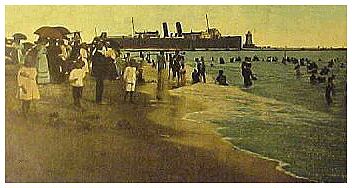
|
Regardless, the expanding popularity of the beach area itself was not lost on some investors. They formed The "Erie Amusement Company" around 1907 (some sources show this as "The Port Stanley Amusement Company"). They purchased property from The London & Port Stanley Railway west of the right-of-way and the lake waterfront. This included The Fraser House Hotel and accompanying beach. After the hotel was renovated, they changed its name to "Invererie" and added lawn bowling, a dance hall, and an open-air roller rink.
On the opposite side of the waterfront, they built a boardwalk along the upper edge of the beach where they leased space to concessionaires, some of whom established an open-air theater, refreshment stands serving ice cream, fruit & hamburgers, a photography studio, a bowling alley, and games. One company made Mackie's Orangeade, The Drink that Made Port Stanley Famous, which is still available during the summer months. A booth for this product was opened on the beach by George Mackie in 1911.
Another ride added was a "Figure 8" roller coaster. Built in 1909, it was located at the beach's west end at the base of The Incline Railway which ran up the hill between the beach boardwalk and Picnic Hill.
|
Figure 8
Early 1910s  |
| A grainy photo shows the coaster as seen from the beach. The boardwalk is in the foreground. Out of frame to the right is the entrance to The Incline Railway. Above lies Picnic Hill. |
Riders were charged 5 cents per go-around with the first day's gross supposedly exceeding $1,600.00! This is surely an exaggeration. The ride ran four-passenger, single-cars. That dollar amount works out to 8000 fully-loaded car-circuits, which means a car dispatched every 10.8 seconds for that 24 hours. Since 24-hour park operation was unlikely, I suspect the figure, if it's even true, may have been for the first week of operation. Even at that, it still means one fully-loaded, 4-person car being launched about every 1 and 1/4 minutes for 24 hours a day, for seven days. Using a more reasonable 12-hour-a-day operation, each car would still have to have been launched every 37.8 seconds. That is not impossible, but if factual, it certainly meant an efficient, yet very tired crew!
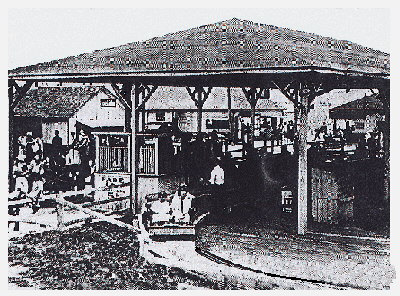 |
Figure 8
Station Early 1910s |
| A car has just been dispatched from the station. Note the ticket booth at the left with rides going for 5 cents each. |
A card postmarked "1926" (below) shows the beach and boardwalk with the roller coaster partly visible in the background. It is not known how long this ride was at the beach, but it likely did not make it very far into the 1930s due to The Depression - if it even lasted that long. Most "Figure 8" rides were gone by the 1920s.
After it was removed, materials from it were used in part to erect cottages in the area, and some of the large beams were used as posts near Mackie's Refreshment Booth, which was located close to the ride.
|
Stanley Beach circa World War I The board walk on the right separates the main beach area from the rides. The "Figure 8" structure may be seen at the upper right. Trees on the bluff conceal Picnic Hill. |

|
Canada's first flights of a seaplane were held here as an exhibition July 17 - 19, 1912. Walter Brookins was the pilot who had been hired by The Canadian Electric Traction Company. They wanted to promote their new rail service to Port Stanley from London and St. Thomas. The event drew the largest crowds ever to the beach until that time, with over 10,000 alone on the first day.
Walter and a member of the press, L. Bradley, who had paid $50 for the privilege, soared for a few minutes and then touched down to the accolades of the onlookers. This first for Canada was seconded when a day or so later, a female press member became the first woman in Canada to fly in a seaplane. Her name was Dorthy Labatt.
As the area grew, other financiers saw potential, so in 1908, the partnership of Scott & Hopkins convinced other investors to buy Hough's Bath House upon whose property a year later opened The Stanley Beach Casino (also known as "Hopkin's Stanley Casino" at some time during its run). This, along with a first-floor refreshment stand and dance hall on the second floor, became popular enough that amusement rides and attractions were added including a carousel, a 10-tub, 15-metre high, ferris wheel, and a shooting gallery. Since the casino was at the bottom of William Street right on the lake, boat excursions & rentals, diving platforms, and a swimming area were offered.
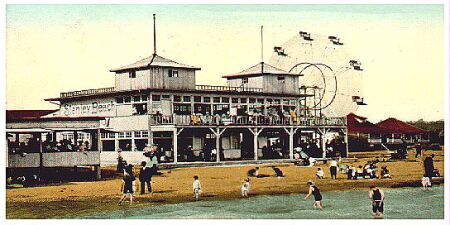
|
The Casino and Beach Circa 1910 |
| This shows The Casino and an open-air pavilion at the left with the ferris wheel to the right. The structure behind the wheel is currently unidentified. |
|
The Casino and Boat Ride Circa 1910 |
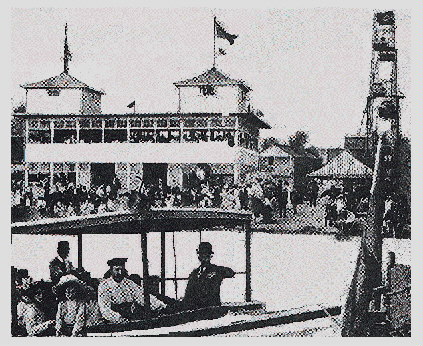
|
| Here is the same scene as above but from a point of view further to the right. The people in the foreground are enjoying a boat ride on The Rambler. In the right background is the Ferris Wheel. |
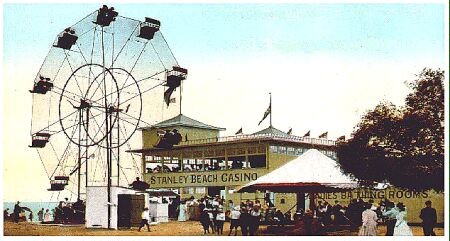
|
Ferris Wheel
Circa Early 1910s |
|
This view has come around to the side
of The Casino, as compared to above.
So the beach is now to the left.
It shows the ferris wheel. Note the
unusual wheel design.
The device at Bottom Right is unknown. It may be a manual carousel, or just a covered platform. Note the "Ladies Bathing Rooms" sign behind that. |
The casino would expand several times in the next decade or so, and be eventually torn down to build a newer, larger one featuring a huge 1000 square-metre, unobstructed dance floor with the bands placed in balconies. The cover charge was 35 cents (or 65 cents/couple) and five cents a dance.
Next to The Casino would be built a bowling alley, penny arcade, photo studio, and refreshment stands. Disaster would strike in April of 1932 when an $80,000 fire destroyed The Casino. With strong competition from the newer, larger Pavilion dance hall (described below), it was decided not to rebuild.
The local railroad, The London and Port Stanley Railway, which had started in 1856 to service the area, was not doing all that well in the early 1870s; and so was leased to a succession of other railroad companies which ran the business. However, they ultimately did not do well either and in 1913, the rail line's ownership fell to the nearby city of London, Ontario which wished to electrify the line.
In order to justify the cost and promote electric railroads, it would have to be shown to be a profitable idea. If it could attract more visitors to the Port Stanley area, the rail traffic would increase, justifying the expense to go electric. Although some facilities were already on the beach, as just described, this would really be the start of the expansion of the waterfront amusements & attractions, but unfortunately also the continuation of the decline of Picnic Hill, despite improvements.
Around the beginning of World War I the railroad began the needed improvements required to bring additional passenger traffic to the area. It installed a second track that was laid next to the first to handle both coming & going traffic to the beach area and a new terminal. It bought The Incline Railway and installed modern turnstiles and a new platform while reducing the 5-cent fare in half to 10 tickets for 25 cents.
Over the next 5 or so years they improved the surrounding grounds with cleanup, levelling, & landscaping, plus the construction of two baseball fields. Later, in 1938, the Benny Goodman and Morgan Thomas bands would play ball there during their off times.
The hillside was enhanced with terraced walkways and a new stairway up to the picnic grounds. On Picnic Hill, lighted paths, washrooms, and more swings were added, along with converting the dance hall into a Japanese Tea Room where meals and light refreshments were offered. The building was painted in white & green and had an open side that faced the lake.
The upper Incline station came to house a canteen, as their patronage had increased due to the improvements to the railroad into the area. One of these was the newly-constructed terminal at the beach which was near enough to The Incline to provide it with business.
The improvements worked - from 1914 to 1919, rail fares went from 132,000 to almost 1 million. On one day alone, The Incline carried over 10,000. This spurred the railroad to replace its antiquated coaches with longer, larger, more ornate ones. Each car had washrooms and drinking fountains.
In 1916, the railroad constructed, right on the beach, the Glenerie Bath House which would be expanded with a cafeteria, plus a 200 square-metre cold storage warehouse across the street. The bathhouse, which opened for the 1917 season, took up 75 metres of boardwalk length and was divided into men's & women's sections complete with showers & toilets, with each area having 50 changing rooms. There were also 322 or 350 lockers (depending on the reference quoted), 150 bathing suits available for rent, and women's electric hair dryers.
A complete laundry was on premises. A swimming area with diving boards, slides, and rafts was provided. It was floodlit so night water activities could be enjoyed. All this was in direct competition with the smaller existing bathhouses. The bathhouse business would cease in the late 1940s, but the building continued to be used to sell novelties, and as storage.
The cafeteria took up the east end of the new bathhouse building. It was buff in colour and had high ceilings with wood trim. All the cutlery was stamped with "L & PS" to remind patrons that this was a railroad company establishment. It was so popular that despite the bathhouse being in the same building and being larger, patrons often referred to the entire structure as The "Cafeteria". The eatery also featured a large dance floor. Later when the cafeteria lost patronage due to boardwalk food outlets, it was converted into an arcade.
Picnic Hill continued to decline with this rising popularity of the beach area. In 1919 The Invererie was torn down, although some of its buildings were moved to the beach or into town, one becoming the Peter Pan Inn. By 1923, the beach was being promoted in the unoriginal manner as the "Coney Island of Western Ontario".
July 29th, 1926 marked the opening of another dance hall called The "Pavilion". It had been constructed of steel on the former site of two booths and a large open-air theater which showed movies, held talent contests and community sing-alongs. The Pavilion, which would later become the famous Stork Club, was at the other end of the boardwalk from Hopkin's Casino and built partially out over the water on pilings.
Although the dance floor was smaller than the Crystal Beach Crystal Ballroom (about 2000 square metres compared to Crystal Ballroom's massive 3500), it had another floor nearly that size downstairs making it the largest dance club in existence in Canada at that time. It rivalled The Palomar in Hollywood, California and Steel Pier in Atlantic City, New Jersey. Over 6000 attended opening night to hear The Vincent Lopez Band. This figure may have been exaggerated because another source states that the largest crowd in early years occurred on July 16th, 1928 when 5,325 attended a dance with Emerson Gil's orchestra. (The largest crowd ever was 7000-plus on September 6th, 1950 for Guy Lombardo and his Royal Canadians.)
Initial cover charges were typically 15 cents with dances at 5 cents each. The problem with that was the floor had to be cleared between numbers so that ticket-takers could keep track of whom had paid. On the other hand, signs were posted before each dance indicating what type of music it would be. Thus waltz fans, or those who preferred other certain types, could decide if they wanted to enter the floor or not.
Throughout the 1930s, and 40s the best of Canadian & American bands and performers appeared at this club. Later in the 1950s, the floors were set up cabaret-club style with tables and chairs ringing the dance area. With this conversion, came a name change to The "Stork Club". To extend the season, the building was heated and media promotions done to garner winter business - and business it was. The club continued to prosper greatly, even as the park declined, and would outlast the amusement area by over two decades.
|
The Stork Club Stage circa 1940s or 50s 
|
Yet another dance floor was available at the beach. It was actually owned by the railroad in competition with its own Pavilion. At the east end of the boardwalk was a bandshell and outdoor terrazzo floor called The "Orient Plaza". This later became a roller rink. There was apparently another open-air dance floor close to this one, as well, but no name has yet surfaced.
In the 1930s there were never fewer than 30 concessions along the boardwalk. Stanley Beach had seen several bathhouses and dance clubs, the coaster, a ferris wheel, 2 carousels, a swing ride, numerous children's rides, a shooting gallery, bowling alley with pool tables & pinball, photo studios, 2 theaters (Erie Playhouse was one), restaurants (including Harper's), a swimming area with water slides & diving platforms, a penny arcade, miniature golf, and numerous games & refreshment stands (including Mackie's, Ross Ice Cream, Theo's Hot Dogs, and The Wimpy Bar).
In 1933, a swimming pool opened on the beach side of The Glenerie Bath House. Presumably, it was heated, as the lake made a pool unnecessary unless it had some fulfilling additional feature. It closed only 5 years later, but the reason has not surfaced.
A 1946 directory shows that all this was reduced to 2 major rides, 10 games, 4 food/beverage outlets, a ballroom, penny arcade, shooting gallery, and the lake/picnic facilities. Although still accessed via both railroad and automobile, things had obviously begun to decline.
A new piece of research says that one of the miniature trains at Springbank Park came here in the 1940s. It was apparently the first of the three trains which had been at Springbank over the years. However, I can find no mention of this in Stanley Beach sources. A photograph exists showing the train, supposedly at Stanley Beach Park. Reproduced below, if this is at Stanley Beach, it must be up on Picnic Hill, given the grass and building in the background. Then too, the shot may have been taken in the 1920s when this train was at Springbank.
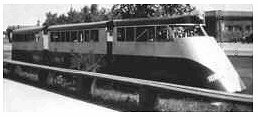
|
This is the streamlined train which had supposedly run at Springbank Park in the early 1920s. The location where this photo was taken is uncertain. |
Stanley Beach faded further in the 1950s as more and more attractions closed their doors. With no gasoline rationing as had been seen during the war, people took their cars, and so traffic on the railroad declined. Passenger service was discontinued in 1957. With more cars and available fuel, people could go farther away to vacation. As well, Lake Erie became increasingly polluted and more people had private pools, thus not needing the beach. The Incline ceased operations in 1966 due to the cost of bringing it up to modern safety standards. The abandoned cars were saved in the 1980s and are now a tourist attraction.
Ken Jones of Niagara Falls, Ontario says " The cars were located at a Knectels store in Port Stanley, until about 2000. They were donated to the Elgin County Railway Museum in St. Thomas, where they were cosmetically restored. They reside there today on the west side of the building."
There were a few concessions left on the beach but the rest of the structures were left to rot and become arson fodder. This did not endear the beach to the public. Although some buildings lived on, the park was essentially gone. Even those buildings were not all to last. The Japanese Tea Room building was removed in 1963 because of a poor state of repair. The huge former 1916 Glenerie Bath House burned in 1973. The Stork Club, which had been completely refurbished over the 1973-74 winter, was badly damaged in a January 1979 blaze set by an arsonist in a garbage dumpster at the rear of the building. It had been losing money despite the improvements, and was too far gone from the fire. It was never rebuilt and the remains were removed by August of that year. Mackie's was torn down, but after the beach was cleaned up, another building was put up near the old location. It survives today.
Today the beach is just that - a beach, with a few refreshment booths. Much of the rest of the property is now a housing development. The old London & Port Stanley Railway right of way runs diesel locomotive with excursion cars. A 0-6-0 steam locomotive is also run by a different group in nearby St. Thomas. It is run on special occasions.
Tim Covell of Ottawa, Ontario has supplied the fact that in 1952 the local council bought an area north of Cavell Boulevard for $18,000. This too was called Stanley Park, but did not contain amusements.
|
Thanks to Dan MacKellar of Lucan, Ontario for additional
material on this park. He in turn wishes to credit "Port Stanley:
Musings and Memories" as the source for some of his information.)
Thanks to Ken Jones of Niagara Falls, Ontario for information on the present trains running in the area. See his site: Niagara's Lost Amusement Parks |
Return to the
Closed Canadian Parks Index
